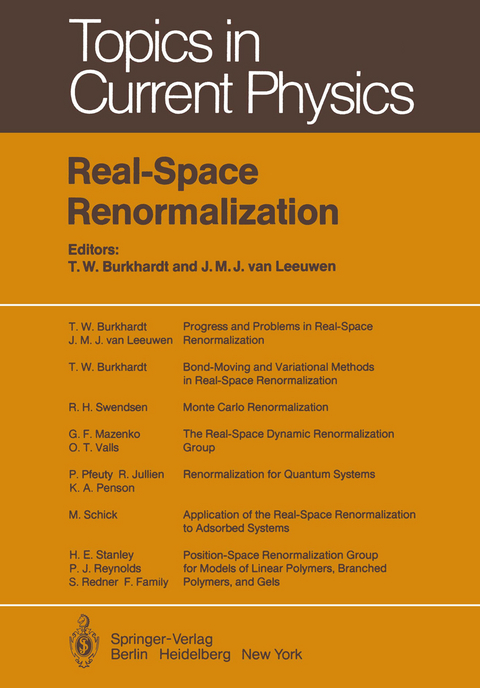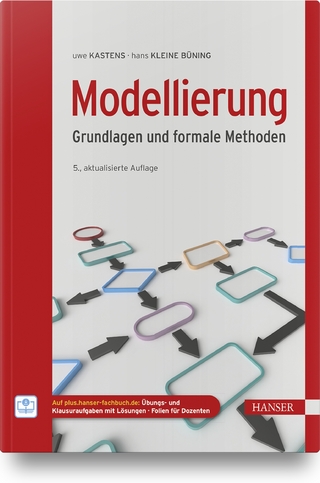
Real-Space Renormalization
Springer Berlin (Verlag)
978-3-642-81827-1 (ISBN)
The renormalization-group approach is largely responsible for the considerable success which has been achieved in the last ten years in developing a complete quantitative theory of phase transitions. Before, there was a useful physical picture of phase transitions, but a general method for making accurate quantitative predictions was lacking. Existent theories, such as the mean-field theory of Landau, sometimes reproduce phase diagrams reliably but were known to fail qualitatively near critical points, where the critical behavior is particularly interesting be cause of its universal character. In the mid 1960's Widom found that the singularities in thermodynamic quanti ties were well described by homogeneous functions. Kadanoff extended the homogeneity hypothesis to correlation functions and linked it to the idea of scale invariance. In the early 1970's Wilson showed how Kadanoff's rescaling could be explicitly carried out near the fixed point of a flow in Hamiltonian space. He made the first practical renormalization-group calculation of the flow induced by the elimination of short-wave-length Fourier components of the order-parameter field. The univer sality of the critical behavior emerges in a natural way in this approach, with a different fixed point for each universality class. The discovery by Wilson and Fisher of a systematic expansion procedure in E for a system in d = 4 - E dimen sions was followed by a cascade of calculations of critical quantities as a function of d and of the order-parameter dimensionality n.
1. Progress and Problems in Real-Space Renormalization.- 1.1 Introduction.- 1.2 Review of Real-Space Renormalization.- 1.3 New Renormalization Methods.- 1.4 New Applications.- 1.5 Fundamental Problems.- 1.6 Exact Differential Real-Space Renormalization.- 1.7 Phenomenological Renormalization.- 1.8 Concluding Remarks.- References.- 2. Bond-Moving and Variational Methods in Real-Space Renormalization.- 2.1 Introduction.- 2.2 Variational Principles.- 2.3 The Migdal-Kadanoff Transformation.- 2.4 Variational Transformations.- 2.5 Conclusion.- References.- 3. Monte Carlo Renormalization.- 3.1 Introduction.- 3.2 Basic Notation and Renormalization-Group Formalism.- 3.3 Large-Cell Monte Carlo Renormalization Group.- 3.4 MCRG.- 3.5 MCRG Calculations for Specific Systems.- 3.6 Other Approaches to the Monte Carlo Renormalization Group.- 3.7 Conclusions.- References.- 4. The Real-Space Dynamic Renormalization Group.- 4.1 Introduction.- 4.2 Dynamic Problem of Interest.- 4.3 RSDRG - Formal Development.- 4.4 Implementation of the RSDRG Using Perturbation Theory.- 4.5 Determination of Parameters.- 4.6 Results.- 4.7 Discussion.- References.- 5. Renormalization for Quantum Systems.- 5.1 Background.- 5.2 Application of the Niemeijer-van Leeuwen Renormalization Group Method to Quantum Lattice Models.- 5.3 The Block Method.- 5.4 Applications of the Block Method.- 5.5 Discussion.- 5.6 What to Do Next?.- References.- 6. Application of the Real-Space Renormalization to Adsorbed Systems.- 6.1 Introduction.- 6.2 The Sublattice Method.- 6.3 The Prefacing Method and Introduction of Vacancies.- 6.4 The Potts Model.- 6.5 Further Applications of the Vacancy.- 6.6 Summary.- References.- 7. Position-Space Renormalization Group for Models of Linear Polymers, Branched Polymers, and Gels.- 7.1 ThreePhysical Systems.- 7.2 Three Mathematical Models.- 7.3 Position-Space Renormalization Group Treatment.- 7.4 Other Approaches.- 7.5 Concluding Remarks and Outlook.- References.
| Erscheint lt. Verlag | 8.12.2011 |
|---|---|
| Reihe/Serie | Topics in Current Physics |
| Zusatzinfo | XIV, 216 p. |
| Verlagsort | Berlin |
| Sprache | englisch |
| Maße | 170 x 244 mm |
| Gewicht | 414 g |
| Themenwelt | Mathematik / Informatik ► Informatik ► Theorie / Studium |
| Naturwissenschaften ► Physik / Astronomie ► Mechanik | |
| Naturwissenschaften ► Physik / Astronomie ► Thermodynamik | |
| Schlagworte | Behavior • Field Theory • Phase • Phase diagram • phase transition • renormalization • Renormalization Group • Renormierung • space • System |
| ISBN-10 | 3-642-81827-7 / 3642818277 |
| ISBN-13 | 978-3-642-81827-1 / 9783642818271 |
| Zustand | Neuware |
| Informationen gemäß Produktsicherheitsverordnung (GPSR) | |
| Haben Sie eine Frage zum Produkt? |
aus dem Bereich


